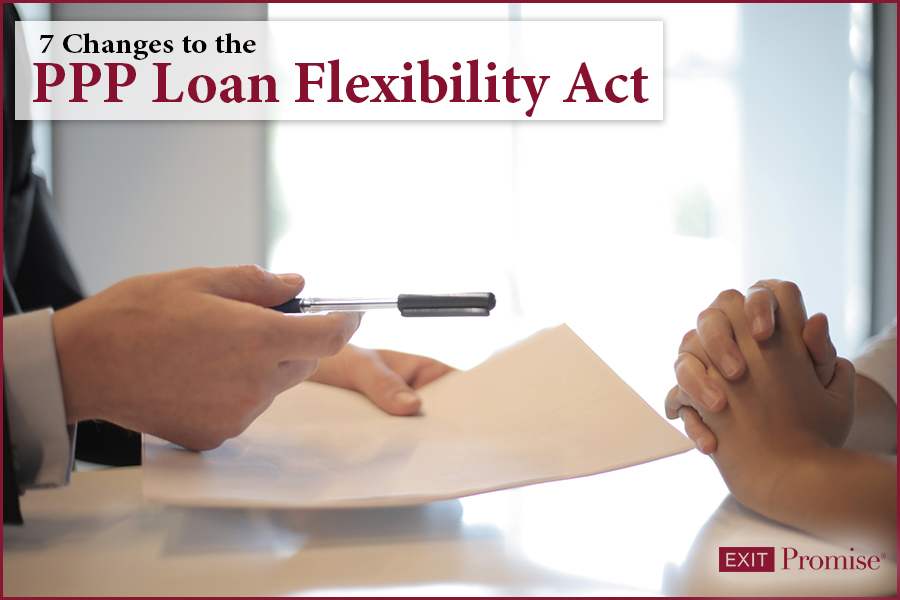- Maximizing After Tax Proceeds When Selling Your Business - June 7, 2024
- Understanding the Accredited Investor Rule 501 of Regulation D - February 27, 2024
- Which is Best – Business Broker, M&A Advisor, or an Investment Banker? - October 2, 2023

On June 5, 2020, President Trump signed into law the Paycheck Protection Program Flexibility Act (PPPFA), which is the latest attempt to save struggling businesses from permanent shutdown.
The Flexibility Act offers business owners seven significant changes to the original Paycheck Protection Program (PPP) Loan terms. The House and Senate were driven to make these changes due to the lengthy pandemic and the fact that many PPP Loan recipients have not been able to re-open their doors for business during the required eight-week ‘covered period’ set forth in the original PPP Loan Act.
The PPP Loan Flexibility Act will make it much easier for business owners to achieve full, or nearly full, loan forgiveness.
The new law provides business owners with seven significant changes to the original law and those include:
1. The Eight-Week Period is Extended to 24-Weeks to spend the PPP Loan Proceeds
This change is optional for business owners. If they’d prefer to stick with the original eight-week covered period when they apply for loan forgiveness with their bank, they may choose to do so.
In certain cases, it may make more sense to use the original eight week period when applying for the loan forgiveness. Such a case may be when the business already spent the proceeds on payroll costs while its doors were closed and are now still unable to cover payroll and operating costs moving forward. The business may be closing altogether.
Because the business owner will need to comply with the original requirement that the employee headcount (or FTEs) may not be reduced by more than 75% during the covered period (or qualify for the June 30, 2020 exception), using the original eight-week period will allow for the forgiveness of payroll costs.
2. The Requirement to Spend 75% of the PPP Loan Proceeds is Reduced to 60%
This change is good for all PPP Loan recipients because the original requirement to reach the 75% payroll costs threshold required many business owners to pay employees who were not working at all or were working fewer hours during the covered period. It also forced many business owners to pay employees one-time bonuses.
It’s important to note that the current law states that the 60% payroll cost threshold is treated as a cliff. There is no loan forgiveness pro rata calculation permitted in the new PPP Loan Flexibility Act if an employer does not pay the minimum 60% payroll costs to its workforce. As with the PPP Loan Act where many changes were made through the SBA’s Final Regulations, this too may change.
3. The June 30, 2020 Deadline to Restore Workforce is Extended to December 31, 2020
In the original law, employers were able to use one of the exceptions to the FTE Reduction rules and had until June 30, 2020 to restore its workforce to pre-pandemic levels. The Flexibility Act now extends this exception all the way out to December 31, 2020.
4. Forgiveness is Available if Unable to Find Qualified Employees
The new law recognizes that for many employers, finding qualified employees during the continuing pandemic can be difficult.
5. Forgiveness is Available if Unable to Restore Operations Due to Pandemic Restrictions
For many businesses, it’s been difficult, and in some cases impossible, to re-open their doors for business. This is particularly true in the hospitality industry where current state mandates severely restrict occupancy. And without normal occupancy levels, it may not be possible for the business to open, operate, and / or breakeven.
6. PPP Loan Repayment Term may be Extended from 2 Years to 5 Years
With the approval of the employer’s SBA Lender, the original two-year loan term may be extended to up to five years.
7. PPP Loan Recipients may Choose to Delay Federal Payroll Tax Payments
The original PPP Loan terms were part of the CARES Act, which included a provision for employers to delay payment of their share of federal social security (FICA & MEDICARE) taxes. The CARES Act did not allow a PPP Loan recipient to take advantage of this provision.
The PPP Loan Flexibility Act now allows business owners to take advantage of this provision.
Conclusion
While it would be great to conclude the PPP Loan Flexibility Act is the final chapter in the pandemic economic mitigation financial aid packages, I truly doubt this is going to be the case.
As with the Paycheck Protection Program Loans, there were many revisions. I expect this will be the case for the PPP Loan Flexibility Act as well. So, stay tuned.
In the meantime, it’s best to revisit your PPP Loan Forgiveness calculations to learn if any of the changes outlined above will help you and your business.












